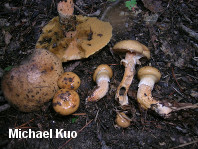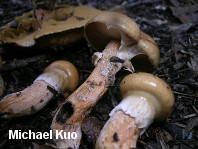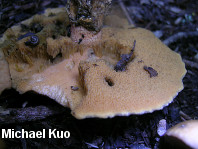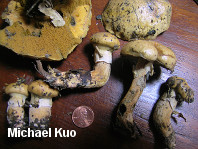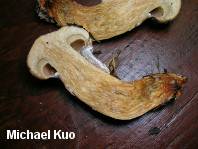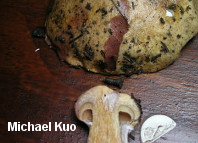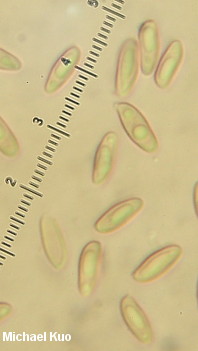| Major Groups > Boletes > Suillus > Suillus salmonicolor |

|
[ Basidiomycota > Boletales > Suillaceae > Suillus . . . ] Suillus salmonicolor by Michael Kuo, 18 November 2022 Suillus salmonicolor is a sticky, dirty orange species of Suillus, associated with jack pine, Virginia pine, and pitch pine in eastern North America. It features a distinctive, glutinous, sheathing ring with a flaring, white, lower edge—along with orange flesh and dark red glandular dots that turn brown to black with age. By current definitions Suillus salmonicolor is the same as "Suillus subluteus" and "Suillus pinorigidus"—and its relationship to the more southerly species Suillus cothurnatus may well be best represented by an equals sign. See the linked page for a more thorough discussion. Suillus acidus, associated with red pine and eastern white pine, is somewhat similar, but features a yellower cap (especially when young), a narrower, more bracelet-like ring, and cap slime that tastes notably acidic or sour. Description: Ecology: Mycorrhizal with jack pine, Virginia pine, and pitch pine; growing alone, scattered, or gregariously; late summer and fall; originally described from Vermont (Frost 1874); probably widely distributed east of the Rocky Mountains where the host trees occur. The illustrated and described collections are from Kentucky, Michigan, and Ohio. Cap: 3–8 cm; convex at first, becoming broadly convex; slimy; bald, but often appearing streaked under the gluten; dull coppery orange, with brownish to grayish streaks and discolorations, becoming brownish orange with maturity; the margin at first inrolled. Pore Surface: At first covered with a thick, orangish to grayish partial veil that is baggy and rubbery, with a white roll of tissue on the lower edge; dull cinnamon orange at first, maturing to deeper brownish orange, or yellowish; not bruising; 1–2 angular pores per mm; not boletinoid; tubes to about 1 cm deep. Stem: 4–10 cm long; 1–2 cm thick; equal; covered with glandular dots that are dark brownish red at first but become darker (usually brown to black) with age; whitish to yellowish or orangish; with a thick, sheathing, gelatinous, whitish to orangish ring that usually features a whitish roll of tissue at the bottom and, in age, collapses to form a grayish, bracelet-like band; basal mycelium whitish to pastel orange. Flesh: Yellowish to orangish in cap; darker orange in the stem; deep salmon orange in the stem base; not staining on exposure; often marbled. Odor and Taste: Not distinctive. Chemical Reactions: Ammonia purplish on cap and flesh. KOH purple on cap and flesh. Iron salts negative on cap and flesh. Spore Print: Cinnamon brown. Microscopic Features: Spores 6–10 x 2–3.5 µm; boletoid-fusiform; smooth; yellowish in KOH. Basidia 22–26 x 4–6 µm; clavate; 4-sterigmate. Cystidia in gelatinized bundles, often poorly defined individually; 30–40 x 5–10; cylindric to subclavate; thin-walled; smooth; golden brown in KOH. Pileipellis an ixolattice of poorly defined elements 1–3 µm wide, smooth, hyaline in KOH. REFERENCES: (C. C. Frost, 1874) R. E. Halling, 1983. (Singer, 1945; Snell & Dick, 1956; Smith & Thiers, 1964; Snell & Dick, 1970; Smith & Thiers, 1971; Grund & Harrison, 1976; Smith, Smith & Weber, 1981; Halling, 1983; Weber & Smith, 1985; Palm & Stewart, 1986; Both, 1993; Barron, 1999; Bessette, Roody & Bessette, 2000; McNeil, 2006; Miller & Miller, 2006; Ortiz-Santana et al., 2007; Klofac, 2013; Kuo & Methven, 2014; Bessette et al., 2016; Nguyen et al., 2016; Baroni, 2017; McKnight et al., 2021.) Herb. Kuo 09241109. This site contains no information about the edibility or toxicity of mushrooms. |
© MushroomExpert.Com |
|
Cite this page as: Kuo, M. (2022, November). Suillus salmonicolor. Retrieved from the MushroomExpert.Com Web site: http://www.mushroomexpert.com/suillus_salmonicolor.html |
